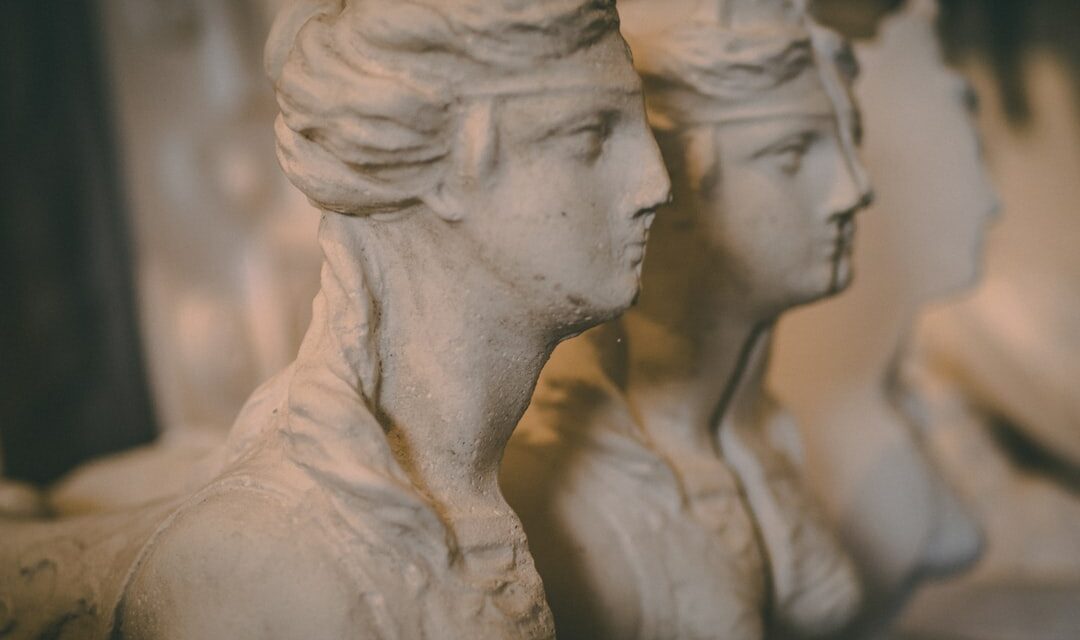Ancient Greek art boasts a rich and captivating history dating back to the 8th century BCE. The art of ancient Greece was profoundly influenced by the culture, traditions and beliefs of the era. The earliest forms of Greek art drew inspiration from the Minoan and Mycenaean civilisations, renowned for their intricate pottery, sculpture and frescoes.
As Greek city-states emerged, they developed their distinctive artistic styles. The evolution of Greek art was further shaped by various conquests and interactions with other cultures, such as the Egyptians and Persians. This resulted in a fusion of artistic styles and techniques that would ultimately define the iconic art of ancient Greece.
The ancient Greeks were celebrated for their appreciation of beauty, harmony and balance, which is reflected in their artistic works. They held the belief that art should mirror the natural world and sought to capture the essence of human emotion and experience. This philosophy is evident in the iconic sculptures, pottery and architecture that have endured to the present day.
The ancient Greeks also placed great importance on storytelling and mythology, which played a significant role in shaping their artistic expression. These early influences established the foundation for the development of ancient Greek art and set the stage for its lasting legacy in Western culture.
Summary
- Ancient Greek art originated in the 8th century BC and was influenced by the Minoan and Mycenaean civilizations.
- Ancient Greek art has had a profound influence on Western culture, particularly in the fields of architecture, sculpture, and pottery.
- Different styles of ancient Greek art include the Geometric, Archaic, Classical, and Hellenistic periods, each with their own unique techniques and characteristics.
- Ancient Greek art played a significant role in religion and mythology, with sculptures and pottery often depicting gods, goddesses, and mythical creatures.
- Notable examples of ancient Greek art include the Parthenon, the Venus de Milo, and the Discobolus, which continue to inspire artists and architects today.
- The legacy of ancient Greek art can be seen in modern art, architecture, and literature, with many contemporary artists drawing inspiration from its timeless beauty and craftsmanship.
- Preserving and studying ancient Greek art is important for understanding the history and cultural significance of this influential artistic tradition.
The Influence of Ancient Greek Art on Western Culture
The Enduring Legacy of Ancient Greek Art
The classical ideals of beauty, harmony, and proportion that were central to ancient Greek art have been revered and emulated by artists and thinkers throughout history. The legacy of ancient Greek art can be seen in the works of Renaissance artists such as Michelangelo and Leonardo da Vinci, who drew inspiration from Greek sculptures and philosophy.
Ancient Greek Art and the Renaissance
The revival of classical art during the Renaissance period sparked a renewed interest in ancient Greek culture and aesthetics, leading to a resurgence of classical motifs in Western art and architecture. The influence of ancient Greek art can also be seen in the development of Western philosophy and literature.
Timeless Themes and Enduring Beauty
The ancient Greeks were pioneers in exploring the human experience and the nature of existence, which is reflected in their art and mythology. The enduring themes of love, heroism, and tragedy found in ancient Greek literature have continued to resonate with audiences throughout the ages. The impact of ancient Greek art on Western culture is evident in the enduring popularity of classical motifs and themes in contemporary art, literature, and architecture. The timeless beauty and profound philosophical insights of ancient Greek art continue to inspire and captivate audiences around the world.
The Different Styles and Techniques of Ancient Greek Art

Ancient Greek art encompassed a wide range of styles and techniques that evolved over several centuries. One of the most iconic forms of Greek art is sculpture, which reached its pinnacle during the Classical period. Greek sculptors were renowned for their ability to capture the human form with unparalleled realism and grace.
The use of marble and bronze allowed for intricate details and lifelike expressions that have stood the test of time. Another significant aspect of ancient Greek art is pottery, which was decorated with intricate designs and scenes from mythology. The use of black-figure and red-figure techniques allowed for a high level of detail and storytelling on these vessels.
In addition to sculpture and pottery, ancient Greek art also encompassed architecture, painting, and decorative arts. The Greeks were pioneers in developing architectural styles such as the Doric, Ionic, and Corinthian orders, which continue to influence architectural design to this day. The use of vibrant colours and intricate patterns in ancient Greek painting added depth and dimension to their artistic expression.
The diverse styles and techniques of ancient Greek art reflect the rich cultural tapestry of the time and continue to inspire artists and scholars to this day.
The Role of Ancient Greek Art in Religion and Mythology
Ancient Greek art played a central role in expressing religious beliefs and mythological narratives. The Greeks believed that their gods and goddesses were integral to every aspect of life, and this belief was reflected in their art. Temples dedicated to the gods were adorned with intricate sculptures and friezes that depicted scenes from mythology.
These artworks served as a visual representation of the divine and were intended to inspire awe and reverence in worshippers. The use of symbolism and allegory in ancient Greek art allowed for a deeper understanding of religious concepts and moral values. Mythology also played a significant role in shaping the artistic expression of the ancient Greeks.
The stories of heroes, monsters, and gods were a rich source of inspiration for artists, poets, and playwrights. The use of mythological themes in art allowed for a deeper exploration of human nature, morality, and the human experience. The enduring popularity of ancient Greek mythology has ensured that these themes continue to resonate with audiences to this day.
The role of ancient Greek art in religion and mythology highlights the profound spiritual and cultural significance of these artworks in shaping the identity of ancient Greece.
Notable Examples of Ancient Greek Art
Ancient Greece is home to some of the most iconic artworks in history, many of which have survived to this day. One notable example is the Parthenon, a temple dedicated to the goddess Athena located on the Acropolis in Athens. The Parthenon is renowned for its architectural beauty and intricate sculptures that adorn its exterior.
The Elgin Marbles, which once adorned the frieze of the Parthenon, are now housed in the British Museum in London, where they continue to captivate audiences with their timeless beauty. Another notable example of ancient Greek art is the statue of Zeus at Olympia, one of the Seven Wonders of the Ancient World. This larger-than-life statue was created by the renowned sculptor Phidias and was housed in the Temple of Zeus in Olympia.
Although the original statue has been lost to history, its legacy lives on through descriptions by ancient writers such as Pausanias. The statue was a testament to the skill and artistry of ancient Greek sculptors and remains an enduring symbol of their cultural achievements.
The Legacy of Ancient Greek Art in Modern Times

The Timeless Appeal of Classical Ideals
The classical ideals of beauty, harmony, and proportion that were central to ancient Greek art have been revered by artists throughout history. The revival of classical motifs during the Renaissance period sparked a renewed interest in ancient Greek culture and aesthetics, leading to a resurgence of classical themes in Western art and architecture.
The Enduring Popularity of Ancient Greek Mythology
The enduring popularity of ancient Greek mythology has ensured that these themes continue to resonate with audiences to this day. From Hollywood films to bestselling novels, the stories of heroes, gods, and monsters from ancient Greece continue to captivate audiences around the world.
A Lasting Legacy in Contemporary Architecture
The legacy of ancient Greek art can also be seen in contemporary architecture, where classical motifs such as columns, pediments, and friezes continue to be used as a homage to the enduring influence of ancient Greece.
The Importance of Preserving and Studying Ancient Greek Art
The preservation and study of ancient Greek art are crucial for understanding the cultural heritage and artistic achievements of this remarkable civilization. Ancient Greek art provides valuable insights into the beliefs, values, and artistic expression of one of the most influential cultures in history. By studying these artworks, scholars can gain a deeper understanding of the social, political, and religious dynamics that shaped ancient Greece.
The preservation of ancient Greek art is also essential for future generations to appreciate and learn from these timeless masterpieces. Museums around the world play a crucial role in safeguarding these artworks for posterity and making them accessible to a global audience. Through exhibitions, educational programmes, and research initiatives, museums contribute to our collective understanding and appreciation of ancient Greek art.
In conclusion, ancient Greek art has left an indelible mark on Western culture through its enduring influence on art, literature, philosophy, architecture, and popular culture. The diverse styles and techniques of ancient Greek art reflect the rich cultural tapestry of the time and continue to inspire artists and scholars to this day. The role of ancient Greek art in religion and mythology highlights its profound spiritual and cultural significance in shaping the identity of ancient Greece.
Notable examples such as the Parthenon and the statue of Zeus at Olympia serve as enduring symbols of their cultural achievements. The legacy of ancient Greek art continues to resonate in modern times through its enduring influence on various aspects of contemporary culture. Finally, it is crucial to preserve and study ancient Greek art for future generations to appreciate these timeless masterpieces and gain valuable insights into one of the most influential cultures in history.
If you are interested in learning more about the evolution of art through history, you may want to check out an article on prehistoric art. This article provides an introduction to the art of early human societies, exploring the cave paintings and sculptures that date back thousands of years. You can find more information on this topic by visiting this link.
FAQs
What is Ancient Greek Art?
Ancient Greek art refers to the artworks produced in the Greek-speaking world from the 9th century BC to the 1st century BC. It includes a wide range of art forms such as sculpture, pottery, architecture, and painting.
What are the key characteristics of Ancient Greek Art?
Ancient Greek art is known for its emphasis on naturalistic representation, idealized human forms, and a focus on balance, harmony, and proportion. It also often depicted scenes from mythology and everyday life.
What are the major periods of Ancient Greek Art?
Ancient Greek art is typically divided into the Geometric, Archaic, Classical, and Hellenistic periods. Each period is characterized by distinct artistic styles and developments.
What are some famous examples of Ancient Greek Art?
Famous examples of Ancient Greek art include the Parthenon in Athens, the statue of Zeus at Olympia, the Venus de Milo, and the Discobolus of Myron. These artworks are celebrated for their beauty, craftsmanship, and cultural significance.
What was the significance of Ancient Greek Art?
Ancient Greek art had a profound influence on Western art and culture. It reflected the values and beliefs of ancient Greek society, and its artistic achievements continue to inspire and influence artists and scholars to this day.




